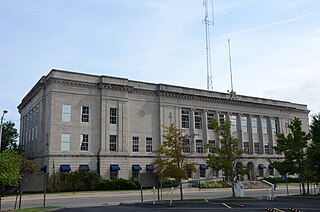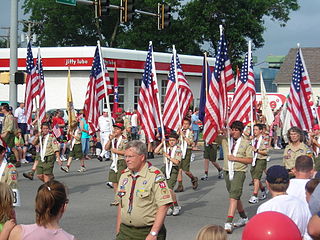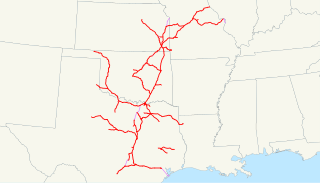
Osage County is the largest county by area in the U.S. state of Oklahoma. Created in 1907 when Oklahoma was admitted as a state, the county is named for and is home to the federally recognized Osage Nation. The county is coextensive with the Osage Nation Reservation, established by treaty in the 19th century when the Osage relocated there from Kansas. The county seat is in Pawhuska, one of the first three towns established in the county. The total population of the county is 47,987.

Muskogee County is a county located in the U.S. state of Oklahoma. As of the 2010 census, the population was 70,990. The county seat is Muskogee. The county and city were named for the Muscogee (Creek) Nation. The official spelling of the name was changed to Muskogee by the post office in 1900.

Scouting in Oklahoma has a long history, from the 1910s to the present day, serving thousands of youth in programs that suit the environment in which they live.

Pawhuska is a city in and the county seat of Osage County, Oklahoma, United States. It was named after the 19th-century Osage chief, Paw-Hiu-Skah, which means "White Hair" in English. The Osage tribal government, which opened offices in Pawhuska in 1872 when its reservation was established in Indian Territory, continues to be based in Pawhuska.

The Missouri–Kansas–Texas Railway was a Class I railroad company in the United States, with its last headquarters in Dallas, Texas. Established in 1865 under the name Union Pacific Railway, Southern Branch, it came to serve an extensive rail network in Texas, Oklahoma, Kansas, and Missouri. In 1988, it merged with the Missouri Pacific Railroad; today, it is part of Union Pacific Railroad.

The Missouri Pacific Railroad, commonly abbreviated as MoPac, was one of the first railroads in the United States west of the Mississippi River. MoPac was a Class I railroad growing from dozens of predecessors and mergers. In 1967, the railroad operated 9,041 miles of road and 13,318 miles of track, not including DK&S, NO&LC, T&P, and its subsidiaries C&EI and Missouri-Illinois.

The St. Louis–San Francisco Railway, commonly known as the "Frisco", was a railroad that operated in the Midwest and South Central United States from 1876 to April 17, 1980. At the end of 1970, it operated 4,547 miles (7,318 km) of road on 6,574 miles (10,580 km) of track, not including subsidiaries Quanah, Acme and Pacific Railway and the Alabama, Tennessee and Northern Railroad; that year, it reported 12,795 million ton-miles of revenue freight and no passengers. It was purchased and absorbed into the Burlington Northern Railroad in 1980. Despite its name, it never came close to San Francisco.

Green Country, sometimes referred to as Northeast Oklahoma, is the northeastern portion of the U.S. state of Oklahoma, which lies west of the northern half of Arkansas, the southwestern corner the way of Missouri, and south of Kansas.
The Kansas, Oklahoma and Gulf Railway (KO&G) was formed on July 31, 1919 from the assets of the bankrupt Missouri, Oklahoma and Gulf Railway. The KO&G largely consisted of a single line from Baxter Springs, Kansas, to Denison, Texas, prior to its purchase by Missouri Pacific's Texas and Pacific Railway in 1964 and merger in 1970.
The Oklahoma City – Ada – Atoka Railway (OCAA) was formed from trackage from Oklahoma City to Atoka via Shawnee, Ada, and Coalgate, Oklahoma. Atoka to Coalgate had been built between 1882 and 1886 as feeder to the old Missouri–Kansas–Texas Railroad (Katy) main line, and Coalgate-Shawnee-Oklahoma City had been constructed by Katy affiliates, and specifically the first 40 miles northwest out of Coalgate having been built by the Texas and Oklahoma Railroad in 1902, and the remaining 78 miles into Oklahoma City having been built in the 1903-1904 timeframe by that line’s successor, the Missouri, Kansas and Oklahoma Railroad Company. However, these properties were not included in the 1923 reorganization of the Katy, and were put in the OCAA instead. The OCAA ended up being sold to the Muskogee Company in 1929, becoming one of the Muskogee Roads.
The Western Association was the name of five different leagues formed in American minor league baseball during the 19th and 20th centuries.

Area codes 918 and 539 are telephone area codes serving Tulsa and northeast Oklahoma. Besides Tulsa, these area codes cover cities such as Bartlesville, Broken Arrow, Claremore, Gore, Jenks, McAlester, Muskogee, Okmulgee, Pryor, Sapulpa, Tahlequah, and northeastern Oklahoma.
The Muskogee Company, although a Philadelphia company, was founded in Delaware on February 27, 1923. The company officers were brothers C. Jared Ingersoll, industrialist, as president, and John H. W. Ingersoll, attorney and industrialist, as vice president and treasurer. The Muskogee Company owned large interests in several railroads in and about northeastern Oklahoma.

The Muskogee Roads was the colloquial name for a system of railroads under common management operationally headquartered in Muskogee, Oklahoma and controlled by the Muskogee Company of Philadelphia. The Muskogee Roads were the only Class I railroads to be headquartered in Oklahoma and had a major impact on the development and livelihood of the region.
The following is a brief history of the North American rail system, mainly through major changes to Class I railroads, the largest class by operating revenue.

Louis Singleton Curtiss was a Canadian-born American architect. Notable as a pioneer of the curtain wall design, he was once described as "the Frank Lloyd Wright of Kansas City". In his career, he designed more than 200 buildings, though not all were realized. There are approximately 30 examples of his work still extant in Kansas City, Missouri where Curtiss spent his career, including his best known design, the Boley Clothing Company Building. Other notable works can be found throughout the American midwest.
The Osage Railway was incorporated in 1921 to accommodate traffic from the oil fields located in the Osage Nation. The first part of its mainline was constructed in 1922 from a connection with the Midland Valley Railroad at Foraker, Oklahoma, to the town of Shidler, Oklahoma, about 10 miles southwest. The line was independently owned from the Midland Valley, but was jointly operated with the Midland Valley and two other lines as part of the Muskogee Roads. Beginning July 2, 1923 and completing in early 1924, the Osage Railway's trackage was extended northwesterly from Shidler through Webb City to Lyman, Oklahoma, about another 6 miles.
The Muskogee Southern Railroad, which existed from 1902 to 1904, constructed only one line in its history. It built south from Muskogee, Oklahoma to the Canadian River, a distance of approximately 37 miles.
The Kansas and Arkansas Valley Railway (“K&AV”) was owner of 170.64 miles of single track, standard gauge steam railroad line, consisting of a 164.63 mile mainline from a junction near Van Buren, Arkansas through Oklahoma to Coffeyville, Kansas, 164.63 miles, with branch lines of 6.01 miles. It began operations in 1888 and sold its property to the St. Louis, Iron Mountain and Southern Railway in 1909.










